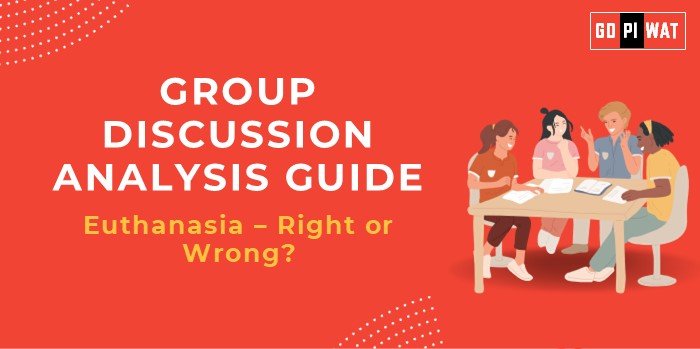📋 Group Discussion (GD) Analysis Guide: Euthanasia – Right or Wrong?
🌐 Introduction to Euthanasia
Opening Context: Euthanasia, often termed “mercy killing,” raises profound ethical, legal, and philosophical questions globally. It involves intentionally ending a life to relieve suffering, sparking debates on individual autonomy, medical ethics, and societal values. For aspiring B-school students, understanding this debate is crucial as it touches on decision-making, ethics, and policy formulation.
Topic Background: The concept of euthanasia dates back to ancient civilizations where the act was both condoned and condemned depending on cultural and philosophical outlooks. In modern times, debates intensified post-WWII due to medical advancements prolonging life. Legal recognition varies globally, with some countries like the Netherlands legalizing it under strict regulations, while others prohibit it entirely.
📊 Quick Facts and Key Statistics
- 🌍 Countries Legalizing Euthanasia: Netherlands, Belgium, Canada (legal under specific circumstances).
- 📈 Global Public Support: Surveys indicate 60-70% favor euthanasia under strict conditions.
- 🔍 Types: Active (administered) and Passive (withholding treatment).
- ⚖️ Ethical Dilemma: Balancing autonomy with medical responsibility.
🤝 Stakeholders and Their Roles
- 👥 Patients and Families: Central to the decision-making, seeking relief from suffering.
- 🩺 Medical Professionals: Weighing ethical codes against patient autonomy.
- 🏛️ Governments and Legislators: Setting legal boundaries and ensuring safeguards.
- ⛪ Ethical and Religious Bodies: Influencing societal norms and moral viewpoints.
🏆 Achievements and Challenges
✨ Achievements:
- 🤝 Autonomy Respect: In countries permitting euthanasia, it empowers individuals.
- 📢 Medical Transparency: Promotes open discussions about end-of-life care.
- 🌐 Global Advocacy: The debate has spurred broader discussions on palliative care.
⚠️ Challenges:
- ❓ Ethical Concerns: Slippery slope fears about misuse.
- 💭 Psychological Pressure: Impact on patients and doctors.
- 🌍 Global Disparities: Inconsistent policies across regions.
🌍 Global Comparisons
The Netherlands: Euthanasia accounts for 4% of deaths annually, with strict protocols.
India: Passive euthanasia legalized in 2018 (Supreme Court ruling in the Aruna Shanbaug case).
Case Studies:
– Aruna Shanbaug (India): Led to the legalizing of passive euthanasia.
– Brittany Maynard (USA): A public face of the right-to-die movement.
💬 Structured Arguments for Discussion
- ✅ Supporting Stance: “Euthanasia empowers individuals to die with dignity and alleviates needless suffering.”
- ❌ Opposing Stance: “The legalization risks exploitation and undermines the sanctity of life.”
- ⚖️ Balanced Perspective: “While euthanasia respects autonomy, safeguards are essential to prevent misuse.”
📖 Effective Discussion Approaches
- 💡 Opening Approaches:
- 🤔 “Should the sanctity of life outweigh individual autonomy in terminal cases?”
- 📊 “With over 60% global support, euthanasia’s acceptance is growing, but ethical concerns persist.”
- 📌 Counter-Argument Handling:
Highlight cases of successful regulation to mitigate fears of misuse.
Emphasize the role of societal consensus in addressing ethical divides.
🔍 Strategic Analysis of Strengths and Weaknesses
- Strengths: Respect for autonomy, focus on reducing suffering.
- Weaknesses: Risk of coercion, cultural and religious resistance.
- Opportunities: Enhancing end-of-life care options, promoting legislative clarity.
- Threats: Potential for misuse, erosion of trust in medical ethics.
🏫 Connecting with B-School Applications
Real-World Applications:
– Policy formulation in health care.
– Ethical decision-making frameworks in leadership roles.
📄 Sample Interview Questions:
- 💬 “Do you believe euthanasia aligns with corporate social responsibility principles?”
- 💡 “How would you balance empathy with ethics in decision-making?”
Insights for B-School Students:
– Explore ethical leadership.
– Study international policy implications.


